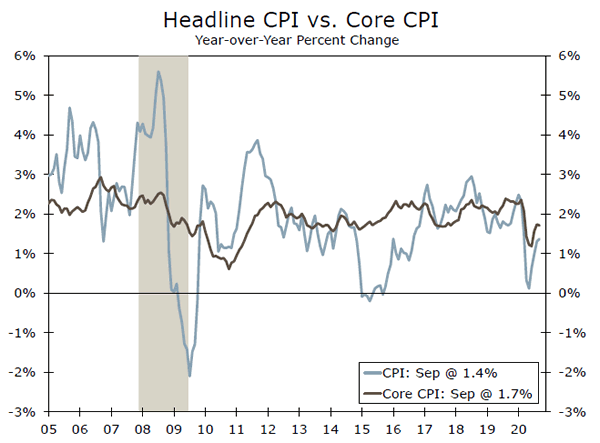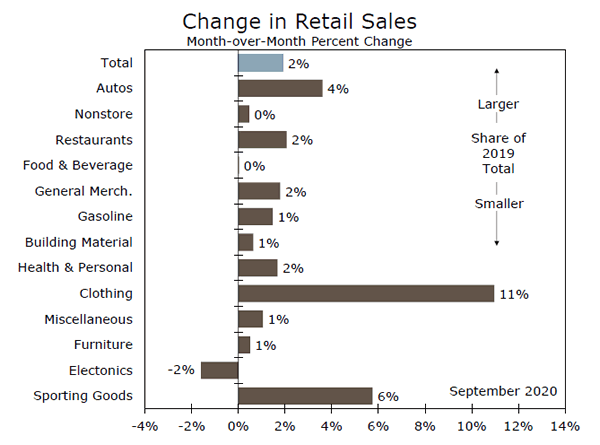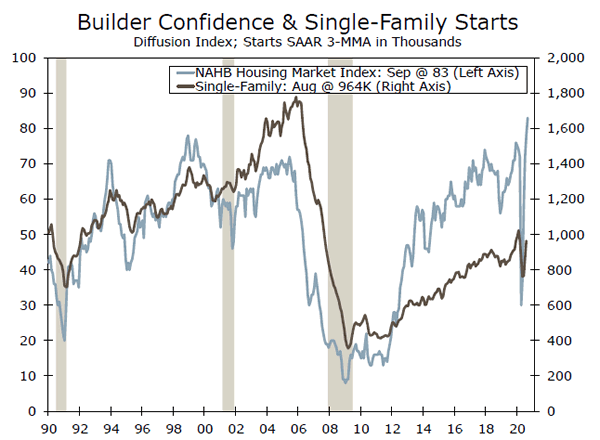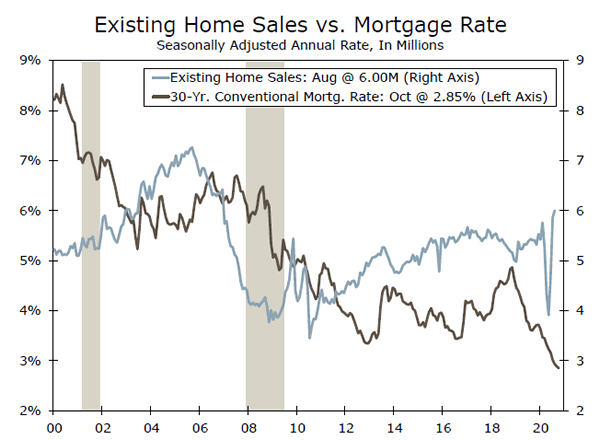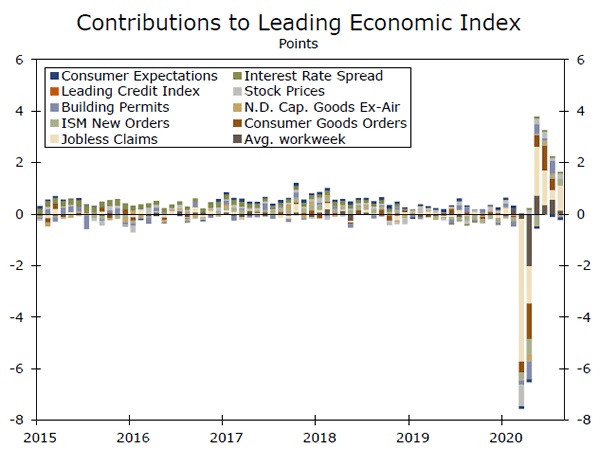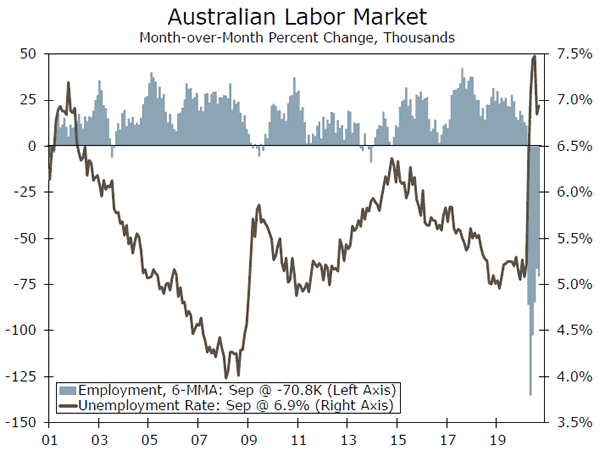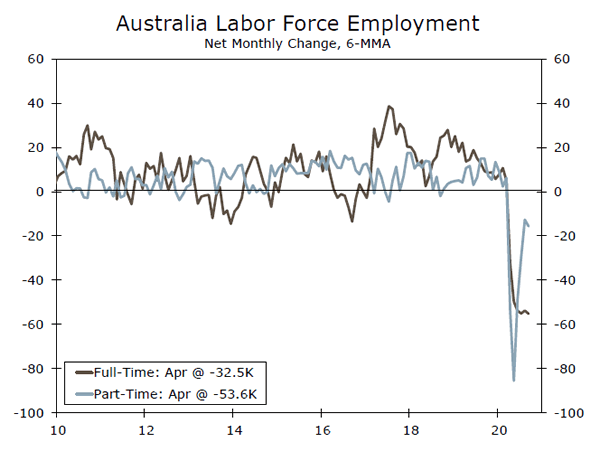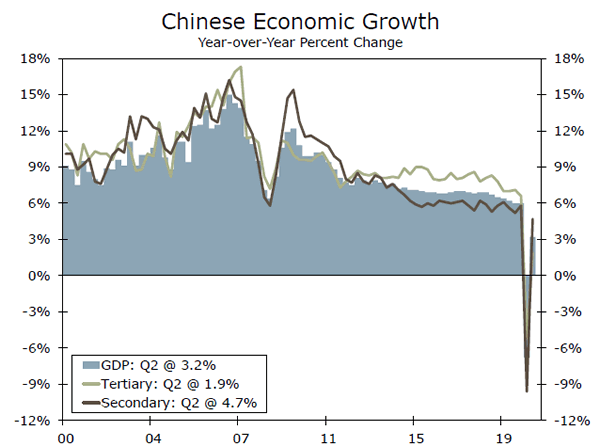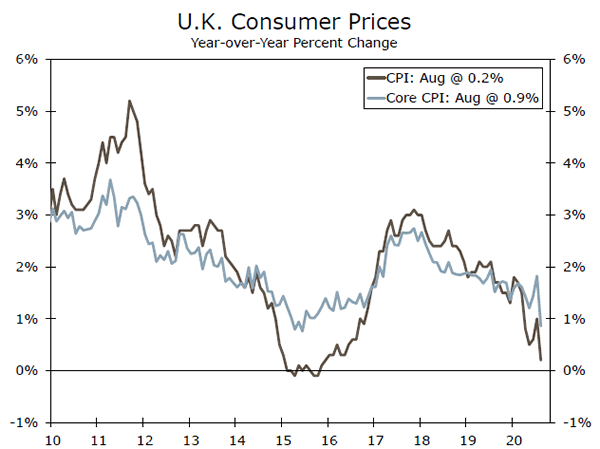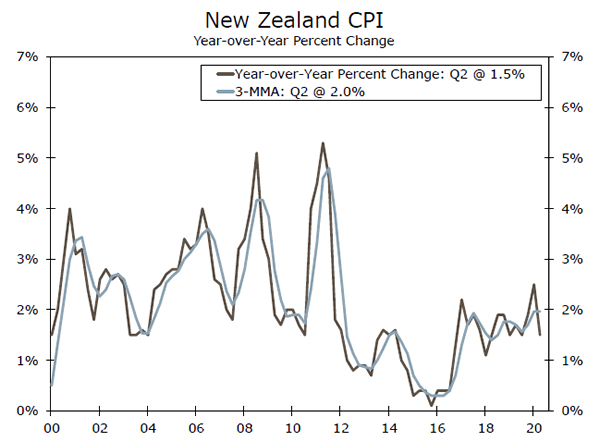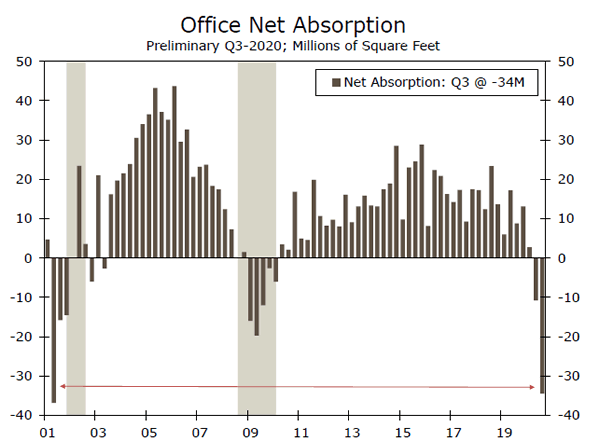U.S. Review
Rebound Continues, but Initial Claims and Cases Rise
- Data continue to reflect an economy digging itself out of the lockdown-induced slump.
- Consumer prices and retail sales rose in September as activity continued to pick up, but a rise in initial claims for state unemployment benefits last week points to continued churn in the labor market.
- Stimulus talks regarding an additional fiscal relief package continued this week, but an agreement remained elusive.
- COVID-19 case counts are on the rise in the Midwest, presenting renewed concern of localized setbacks.
Rebound Continues, but Initial Claims and Cases Rise
Consumer prices rose for the fourth consecutive month in September after lockdowns led to a sharp drop in prices earlier this year. Some of the underlying price categories, however, continued to exhibit effects of the pandemic. Food at home, or grocery, prices, for example, fell for the third consecutive month after run-ups as consumers increasingly relied on food at home during lockdowns. Similarly, restaurant prices rose by the most in a single month in 12 years (up 0.6%), as reopenings have led to a pick up in demand, and perhaps some restaurant owners upping prices to compensate for making their establishments virus-acceptable (limiting capacity, disinfecting processes/equipment, etc.). Furthermore, reflecting the broader economy, prices for core services remain under pressure. Shelter costs have only eked out modest gains in recent months, holding back core services. A further drop in airfare and motor vehicle insurance also continued to weigh on service costs, two categories of prices that have been hit hard from changing consumer behavior in recent months. In terms of input prices, September marked the first pick up in producer prices since prior to the virus-related slump in March. Overall, we expect inflation to climb higher over the remainder of the year, but to remain below its pre-pandemic trend as the demand backdrop remains generally weak, particularly for services. Muted inflation pressure will allow the Fed to keep its accommodative measures in place for quite some time and, perhaps more importantly, allow it to focus on the labor side of its dual mandate.
On that note, there was further evidence this week of continued churn in the labor market, with new applications for state level unemployment benefits unexpectedly rising by 898K last week. This is the latest indication that the recovery is not necessarily far-reaching at present. While the total economy has added jobs over the past five months, many businesses are reassessing their need for labor, particularly in this time of decreased demand. The number of total unemployment benefit recipients is still elevated at 25.3 million, despite dwindling household stimulus. An agreement on an additional COVID-fiscal relief package remained elusive this week, despite continued talks and President Trump saying he would accept a larger package. Even with fears of a fiscal cliff pulling the rug out from under consumption, there has been little evidence of dwindling stimulus holding back consumer spending thus far. Retail sales rose a solid 1.9% in September, suggesting a fair bit of momentum headed into the fall. We recently laid out our outlook for consumer spending in a three part series, in which we highlighted elevated personal savings providing some extra cash to cushion spending in the coming months. Although excess savings won’t last forever, it should prevent consumption from falling off a cliff. The underlying data by retailer suggest consumers continued to spend a considerable amount on goods in September, and as this goods surge fades, we expect it will be met with a modest pick up in the larger services component, though any real-rebound there truly depends on the trajectory of the virus. A renewed pick up in COVID-19 case counts in certain areas of the country, particularly in the Midwest, has raised concern of continued recovery. We still believe governors will remain under a considerable amount of pressure not to impose lockdowns to the extent they did earlier this year to curb the spread. Nonetheless, rising case counts can still cause localized setbacks in activity, something we will continue to monitor.
U.S. Outlook
Housing Starts • Tuesday
We are looking for a below-consensus modest 0.8% rise in September housing starts to 1.427 million units. The consensus is looking for a slightly larger gain. The final count on August building permits was revised to be marginally higher and now shows 1.476 million unit permits versus an earlier reported 1.470 million, which may pull forecasts slightly higher. With the NAHB homebuilders’ index at an all-time high of 83, it is not difficult to make a case for another strong report. Starts also likely fell less this September than they normally do, which would boost the seasonally-adjusted data.
Our below-consensus forecast is based on some mean reversion of starts in the Midwest and West, which jumped this past month. The Western wildfires might lead to an even larger pullback. Inventories of new homes and buildable lots also remain in short supply. Moreover, higher lumber prices have likely modestly curbed builders’ enthusiasm for building spec homes.
Previous: 1.416M Wells Fargo: 1.427M Consensus: 1.452M (SAAR)
Existing Home Sales • Thursday
We are looking for an above-consensus 6.2% rise in September existing home sales, versus a 3.3% consensus increase. Our stronger estimate is based on the continued strength in pending sales and mortgage purchase applications, as well as strong reports from realtors around the county. We doubt the Western fires will have much impact on the September data and seasonal-adjustment factors might push the number beyond our estimate.
Existing home sales are being limited by low inventories and diminishing affordability. Right now, however, lower interest rates and the quest for more living space could easily clear those hurdles. The median price of an existing home sold in August was up 11.4% from the prior year. Intense competition for the relatively few homes available for sale should continue to pull prices higher.
Previous: 6.00M Wells Fargo: 6.37M Consensus: 6.20M (SAAR)
Leading Economic Index • Thursday
We are looking for the Index of Leading Indicators (LEI) to rise 0.4% in September, roughly half the consensus estimate. The LEI rose 1.2% in August but should post a smaller rise in September based on the pull-back in share prices and a slightly flatter yield curve. The improvement in weekly jobless claims also moderated during the month and building permits were likely either flat or down slightly.
The Index of Coincident Indicators also likely posted a smaller rise in September than it did the prior month, particularly following September’s disappointing industrial production number. The Coincident Index has done a good job of capturing the loss of momentum in the broader economy, having risen 3.9% in June, 1.2% in July and 0.6% in August.
Previous: 1.2% Wells Fargo: 0.4% Consensus: 0.8%
Global Review
Data Underwhelming This Week
- Swedish inflation slid more than expected in September, with headline and core CPIF remaining well-below the Riksbank’s 2% target inflation rate.
- Australia’s employment declined by 29,500 in September, the first decline since May, while the unemployment rate edged higher to 6.9%. The slump in the labor market in part reflects the Stage 4 restrictions in Victoria put in place to contain the spread of COVID-19.
- Chile’s central bank held its policy interest rate at 0.50% at this week’s meeting, and did not announce any new quantitative easing measures.
Swedish Inflation Set to Remain Below Riksbank’s Target
Swedish inflation has been lower than expected in recent months amid falling electricity and fuel prices, which weighed on headline and underlying inflation rates. Consumer prices slipped lower in September, with CPIF inflation rising just 0.3% year-over-year, down from 0.7% in August. The weak reading was due in part to a significant drop in prices of package holidays. In addition, the decline in food and non-alcoholic beverages prices were unusually large in September, which led to a negative contribution to overall inflation. Meanwhile, CPIF ex-energy inflation slowed to 0.9% year-over-year, the lowest since 2014. Both measures remain well below the Riksbank’s inflation target of 2%. The central bank recently cut its inflation forecasts slightly as inflation has fallen, and looks for CPIF inflation to rise to just 1.2% and 1.3% in 2021 and 2022, respectively. With inflation averaging around 0.5% this year, we also look for headline inflation to hold below the central bank’s 2% target through 2022.
Australia Employment Slumps in September
Australia’s labor market slowed in September—although by less than expected—due in part to the Stage 4 restrictions in Victoria weighing on the recovery. Employment in Victoria fell by 36,000, after falling 37,000 the previous month. Nationally, employment declined by 29,500 after three months of positive gains, while the unemployment rate increased to 6.9%. The details of the report indicated full-time jobs and part-time jobs fell by 20,100 and 9,400, respectively, while the underemployment rate increased 0.1 percentage points to 11.4%. However, the participation rate remained relatively unchanged over the month. This week’s report provides the latest insights into how the Australian labor market is affected from the lockdown in Victoria. Given that Australia has made progress toward the reopening of Victoria and the first step to the reopening of its boarders, allowing New Zealanders into New South Wales state and the Northern Territory, we expect the labor market will continue to recover in the second half of this year.
The RBA has kept an eye on the labor market’s developments throughout this year. This week, Reserve Bank of Australia (RBA) Governor Lowe indicated that the board is assessing whether purchasing longer dated bonds could support jobs, incomes and businesses. Lowe also said the RBA wants to see a return to labor market conditions that are consistent with inflation within the 2%-3% target range.
Chile’s Central Bank on Hold
At its monetary policy meeting this week, the Central Bank of Chile opted to hold rates steady at 0.50% and did not announce any new quantitative easing measures. The board indicated that it would hold the monetary policy interest rate at its minimum level over most of next two years and would also maintain its current nonconventional measures. Policymakers remain cautious about the Chilean economic outlook, noting that the economic recovery across Latin America is lagging other emerging regions, although it did acknowledge August activity data improved.
Global Outlook
China GDP • Monday
China is leading the global economic rebound, and the country’s strong underlying fundamentals indicate the recovery should continue. Activity indicators in August beat expectations, with industrial output rising 5.6% year-over-year, while retail sales gained 0.5%. In addition, leading indicators continue to show signs of improvement, with the PMIs pushing higher into expansion territory. Next week’s release of China’s Q3 GDP will provide the latest detail on the recovery’s strength. We suspect the recovery remained uninterrupted in Q3 and look for GDP to rise 5.2% year-over-year.
Next week’s releases also include September industrial production, which is forecast to firm to 5.8% year-over-year. September retail sales are also due and are expected to accelerate 1.6% year-over-year.
Previous: 3.2% Wells Fargo: 5.2% Consensus: 5.5% (Year-over-Year)
U.K. CPI Inflation • Wednesday
In recent weeks, new cases of COVID-19 have risen across the United Kingdom, which led to a partial re-imposition of lockdown restrictions and could threaten the country’s economic rebound. The pace of the U.K. rebound has already shown signs of losing momentum, with August GDP rising 2.1% month-over-month, well below the consensus forecast, while August CPI slowed to just 0.2% year-over-year. Next week’s release of the September U.K. inflation report will be of particular interest as any further slowing would support the case for further Bank of England (BoE) easing. Given the recent subpar data, we currently look for the BoE to increase its asset purchase target £100 billion to £845 billion at its November meeting.
Next week, we will also get U.K.’s retail sales figures, which should rise 0.3% month-over-month. The manufacturing and service sector PMIs are also due and are expected to edge lower but remain in expansion territory in September.
Previous: 0.2% Wells Fargo: 0.6% Consensus: 0.5% (Year-over-Year)
New Zealand CPI Inflation • Thursday
New Zealand’s Q2 CPI fell toward the lower end of the Reserve Bank of New Zealand’s (RBNZ) 1%-3% target range, with headline inflation slowing to 1.5% year-over-year. On a quarterly basis, CPI declined 0.5%. The slump in oil prices was a key driver of the lower inflation prices as transportation fell 4.2% year-over-year, with petrol prices down 13%. Clothing and footwear also weighed on headline prices, declining 0.9% and 10.3%, respectively.
The RBNZ has previously noted that the outlook for inflation remains subdued, with the most recent projections indicating annual inflation could fall to as low as 0.3% in Q3-2021. Although inflation is currently at the lower end of the target, the central bank aims to get inflation to the middle of its target band within a one-to-three year horizon. Another weak inflation report next week would add support to our view that the central bank may need to implement negative rates sometime in Q2 of next year.
Previous: 1.5% Consensus: 1.7% (Year-over-Year)
Point of View
Interest Rate Watch
“Experienced” Inflation Helping Boost Inflation Expectations
The September CPI report showed that inflation will not be quick to rise to the rate Fed officials desire anytime soon. The rebound in prices after outright declines this past spring is slowing, with the overall price level up just 1.4% over the past year— the same increase indicated by the PCE deflator through August (top chart).
The Fed prefers to track its mandate of price stability against the PCE deflator. One of the reasons for its emphasis on the PCE deflator is that it is more dynamic than the CPI and quicker to reflect changes in consumer buying patterns. But, even the PCE deflator does not fully reflect the price changes consumers are experiencing when their shopping patterns change rapidly—like during a pandemic—since the index uses a mix of current-period weights and base-period weights.
For example, households are not substituting meals at home for meals at restaurants just because grocery prices have risen faster this year. In fact, grocery prices are up 4.1% from a year ago and account for a higher share of purchases. Meanwhile, rather than buying more of some items as prices fall, like gasoline and airline tickets, consumers are buying less.
Reweighting the PCE deflator using only households’ current buying patterns, the PCE deflator would be up 1.7% over the past year instead 1.4% as officially reported. That suggests that future revisions will be upward and closer to the Fed’s aim of 2%.
While still short of the Fed’s goal, the rapid shift in buying patterns and higher inflation experienced by households versus what the official numbers currently reflect are likely supporting higher inflation expectations. Household inflation expectations have moved higher since the pandemic, both for the near term (middle chart) and medium term (bottom chart). Given that inflation expectations have taken on greater importance than economic slack in recent decades, the upward move in expectations could support the Fed’s efforts to drive inflation higher.
Credit Market Insights
Renewed Consumer Optimism
The Survey of Consumer Expectations (SCE) released by the New York Fed this week indicated households are optimistic, but remain uncertain. The labor market outlooks generally improved. The share of respondents expecting the unemployment rate to be higher a year from now decreasing to 36.4%, below the 2019 average of 36.9%. Additionally, only 16.6% of respondents anticipated losing their job in the next 12 months, down from 18.0% in August.
Access to credit compared to a year ago and future expectations for credit accessibility were also better. Another recent publication by the New York Fed showed 36.4% of the stimulus checks received were saved and an additional 34.5% were used to pay down debt. If a second round of stimulus were passed, August survey results showed that consumers would save even more (45%) and still use a large percentage to pay down debt (31%). While stimulus helped pay down debt, the decline in Q2 household debt was also partly because of a decrease in credit card balances as consumers refrained from usual spending activities due to the pandemic. That said, the September SCE results signaled a return to usual spending patterns. Median household spending growth expectations edged up to 3.4% to reach its highest reading since May 2019.
Despite these encouraging readings, tepid expectations regarding household income growth showcased concern, likely due to the uncertainty around additional stimulus. The measure only rose 0.1 percentage point to 2.3%, which remains below the 2019 average of 2.8%. Overall, the SCE results indicated consumers expect to return to more typical spending patterns but are concerned over future income.
Topic of the Week
Time Table for an Office Market Recovery
The U.S. economy is on the mend, but the office market continues to lag. The general success of work-from-home policies, together with the prospect of lower occupancy costs amid mounting financial pressures, has led many businesses to reassess their longer-term space needs. Leasing activity remains well off pre-pandemic levels and net absorption posted the sharpest decline in Q3 since the dot-com bust in 2001. Not surprisingly, vacancy rates have risen and rents have softened.
Bearing this in mind, many are likely wondering when firms will be able to resume more normal operations and fully bring back office workers. As with most other indoor and close-contact activities, the time table for a return to the office is largely dependent on COVID-19 itself. According to a recent Conference Board survey, 39% of responding companies plan to bring workers back by the first quarter of 2021. The timing makes sense because multiple vaccines in development are expected to be cleared for distribution early next year. That said, 35% of companies have not yet set a date for reopening, which is a reminder that the path of the virus and viability of a vaccine remains uncertain.
There is also the question of how much space will businesses even need once the pandemic is fully behind us. We still see the office as providing the predominant workspace for office-using industries in a post-COVID environment. Office space plays a key role in fostering collaboration, innovation, culture and productivity—all of which are essential to creating and maintaining a comparative advantage to competitors.
The experience of the past few months has revealed that there are merits to having a certain mix of employees work remotely. Transitioning to a hybrid workforce, where some workers remain remote and still periodically meet in the office, might reduce occupancy costs without a significant drop-off in productivity. Even under this model, firms may need to maintain their current footprint to abide by social distancing requirements, which are likely to remain in place well after the pandemic has ended. The bottom line is that just as e-commerce transformed the retail landscape, we expect the integration of remote work to similarly reduce demand for office space over the long term.





